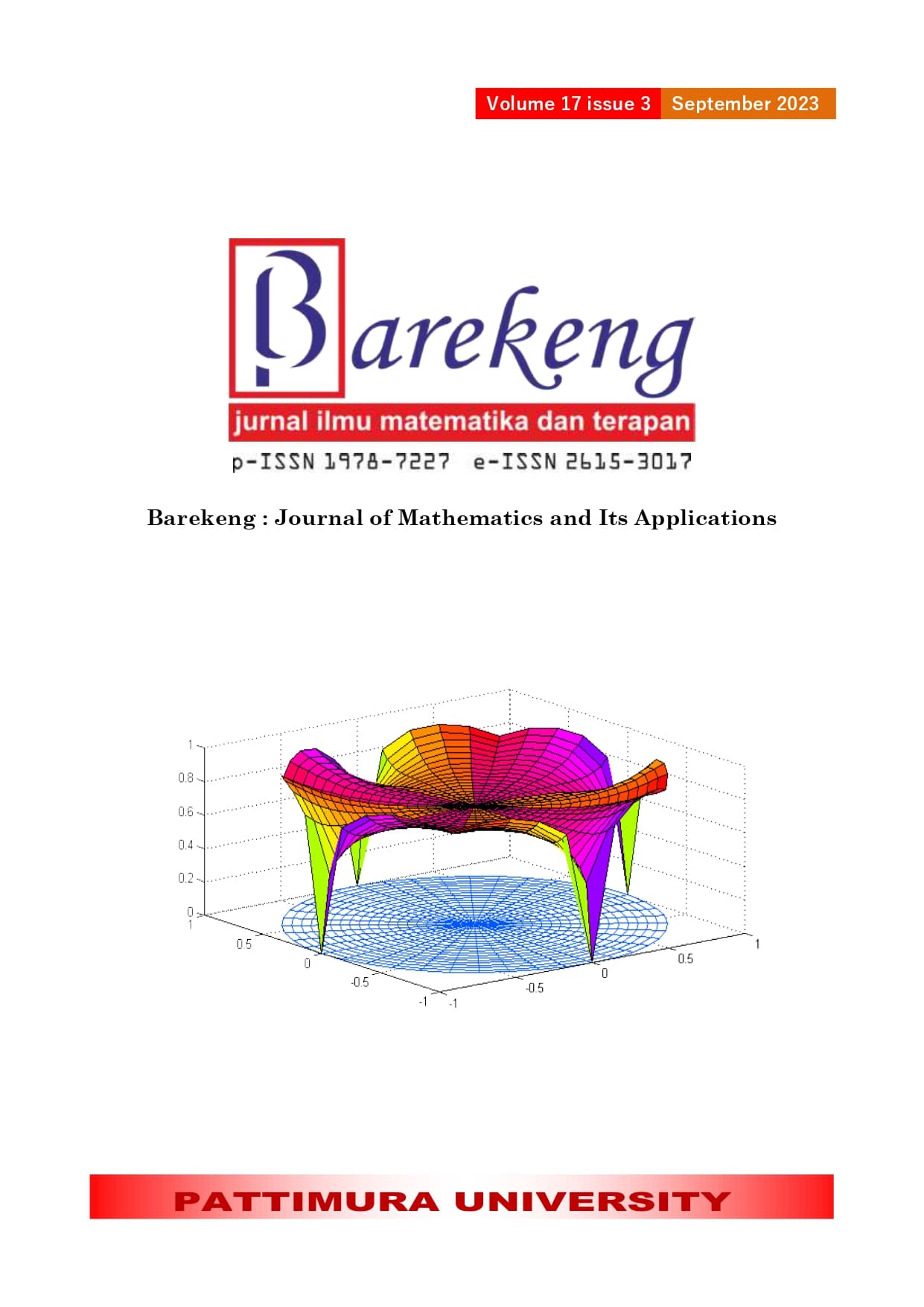ANNIHILATING IDEAL AND EXACT ANNIHILATING IDEAL GRAPH OF RING Z_n
Abstract
The existence of annihilator in the ring motivates the emergence of studies on Annihilating Ideal and Exact Annihilating Ideal Graphs. The purpose of this research is to describe the characteristics of an (exact) annihilating ideal of ring . The method used in this research is literature study. The results of this study discuss finiteness, adjacency, connectedness, vertices, and types of and . Furthermore, the number of vertices of an Annihilating Ideal Graph is determined by the factorization of . The adjacency of two vertices is determined by the divisibleness of . The results also show that is a subgraph of . can be represented as a union of several complete graphs.
Downloads
References
Cayley, “Desiderata and Suggestions: No. 2. The Theory of Groups: Graphical Representation,” American Journal of Mathematics, vol. 1, no. 2, pp. 174–176, 1878.
I. Beck, “Coloring of Commutative Rings,” J Algebra, vol. 116, pp. 208–226, 1988.
S. Bhavanari, “Prime Graph of a Ring,” Journal of Combinatorics, Information and System Sciences, vol. 35, no. 1, pp. 27–42, 2010.
D. F. Anderson and P. S. Livingston, “The Zero-Divisor Graph of Commutative Ring,” J Algebra, vol. 217, 1999.
Premkumar and T. Lalchandani, “Exact Zero-Divisor Graph,” International Journal of Science Engineering and Management (IJSEM), vol. 1, no. 6, 2016.
P. T. Lalchandani, “Exact Zero-Divisor Graph of a Commutative Ring,” International Journal of Mathematics and Its Applications, vol. 6, no. 4, pp. 91–98, 2018.
S. Visweswaran and P. T. Lalchandani, “The exact annihilating-ideal graph of a commutative ring,” Journal of Algebra Combinatorics Discrete Structures and Applications, vol. 8, no. 2, pp. 119–138, 2021, doi: 10.13069/JACODESMATH.938105.
A. Badawi, “On the Annihilator Graph of a Commutative Ring,” Commun Algebra, vol. 42, no. 1, pp. 108–121, Jan. 2014, doi: 10.1080/00927872.2012.707262.
D. S. Dummit, Abstract_algebra_Dummit_and_Foote, Third Edition. Danvers: John Wiley & Sons, Inc, 2004.
M. Behboodi and Z. Rakeei, “The annihilating-ideal graph of commutative rings I,” J Algebra Appl, vol. 10, no. 4, pp. 727–739, 2011, doi: 10.1142/S0219498811004896.
P. T. Lalchandani, “Exact Annihilating-Ideal Graph Of Commutative Rings,” Journal of Algebra and Related Topics, vol. 5, no. 1, pp. 27–33, 2017.
S. Visweswaran and P. T. Lalchandani, “The exact zero-divisor graph of a reduced ring,” Indian Journal of Pure and Applied Mathematics, vol. 52, no. 4, pp. 1123–1144, Dec. 2021, doi: 10.1007/s13226-021-00086-9.
S. Arumugam, K. Premalatha, M. Bača, and A. Semaničová-Feňovčíková, “Local Antimagic Vertex Coloring of a Graph,” Graphs Comb, vol. 33, no. 2, pp. 275–285, Mar. 2017, doi: 10.1007/s00373-017-1758-7.
J. Huang, “Domination ratio of integer distance digraphs,” Discrete Appl Math (1979), vol. 262, pp. 104–115, Jun. 2019, doi: 10.1016/j.dam.2019.03.001.
M. Masriani, R. Juliana, A. G. Syarifudin, I. G. A. W. Wardhana, I. Irwansyah, and N. W. Switrayni, “Some Result Of Non-Coprime Graph Of Integers Modulo n Group For n A Prime Power,” Journal of Fundamental Mathematics and Applications (JFMA), vol. 3, no. 2, pp. 107–111, Nov. 2020, doi: 10.14710/jfma.v3i2.8713.
Copyright (c) 2023 Anindito Wisnu Susanto, Dewa Putu Wiadnyana Putra

This work is licensed under a Creative Commons Attribution-ShareAlike 4.0 International License.
Authors who publish with this Journal agree to the following terms:
- Author retain copyright and grant the journal right of first publication with the work simultaneously licensed under a creative commons attribution license that allow others to share the work within an acknowledgement of the work’s authorship and initial publication of this journal.
- Authors are able to enter into separate, additional contractual arrangement for the non-exclusive distribution of the journal’s published version of the work (e.g. acknowledgement of its initial publication in this journal).
- Authors are permitted and encouraged to post their work online (e.g. in institutional repositories or on their websites) prior to and during the submission process, as it can lead to productive exchanges, as well as earlier and greater citation of published works.






1.gif)



